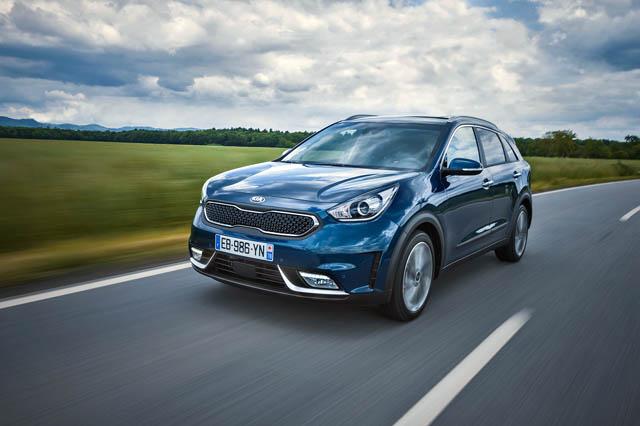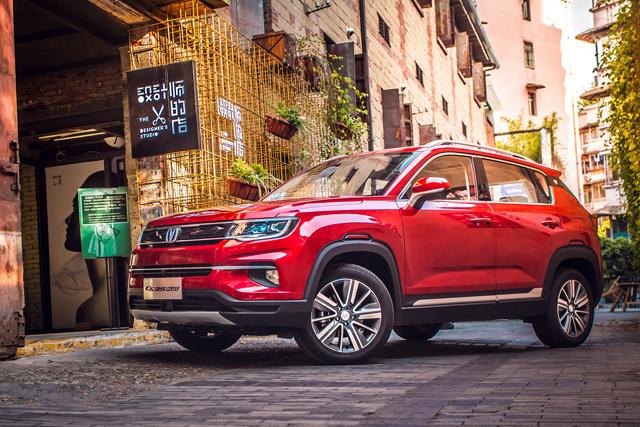You are here
Kia Niro Plus HEV: Practical segment-crossing hybrid’s encore edition
By Ghaith Madadha - Jul 10,2023 - Last updated at Jul 10,2023

Photo courtesy of Kia
Introduced globally early last year, the Kia Niro Plus arrived just months after the late 2021 launch of an all-new second generation Kia Niro. The Niro Plus is in essence a more spacious legacy model derived from the first generation model, circa 2016.
Designed as more practical and accommodating version of the Korean manufacturer’s segment-bending and purpose-built hybrid that combined an assertive Crossover aesthetic with MPV-like utility, the Niro Plus’ slightly higher roofline, however, leans into latter side of its persona.
Confident continuation
Intended as a more accommodating an accessible car for certain markets such as the Middle East, the Niro Plus was also designed to serve as a taxi for other markets, where its low fuel consumption and enhanced cabin space would be of particular benefit. Bucking the trend for ever lower rooflines in favour of the practicality and comfort of an 85mm higher roof that deliver excellent rear headroom, the Niro Plus cuts a more upright and individualistic shape among competitors.
Otherwise little changed in dimensions and basic design, the Niro Plus retains the outgoing Niro’s aggressively swept back diamond-like headlights, convex and concave surfacing, sculpted sills and rear light deign. It does, however, gain a more aggressive facia with bigger lower side light housing and light elements. Its lower air intake is meanwhile noticeably wider, and makes up for the loss of an actual grille opening, which is now replaced with a textured body coloured panel in place of the previous Niro’s grille mesh.
Frugal efficiency
Designed from the ground up for service as either a hybrid of EV, the Niro Plus is better weighted and better integrates hybrid components than most cars that are converted from conventional combustion engine designs to hybrids. It also features comparatively lighter batteries and construction, at least for when it was first launched as the original Niro. Under its bonnet, the Niro Plus retains the same naturally aspirated direct injection 1.6-litre four-cylinder engine driving the front wheels, and assisted by an electric motor.
With its thermally efficient but somewhat low-revving Atkinson cycle combustion engine producing 103BHP at 5,700rpm and 108lb/ft at 4,000rpm, and electric motor developing 43BHP and 125lb/ft, the Niro’s maximum combined system output is 139BHP and 195lb/ft. With both motors working in unison or individually, depending on conditions, throttle input and battery charge, the Niro is perkier than stats suggest, with its electric motor’s near instant torque allowing for confidence from low speed and in mid-range, while fuel consumption is frugal at 4.3l/100km, combined.
Smooth and refined
Capable of estimated 0-100km/h acceleration in 11.5-seconds and a 162km/h top speed, the Niro Plus’ hybrid system is smoother and better integrated than lesser hybrids, especially on throttle lift-off response when driven hard. Able to drive briefly in electric-only mode, the Niro Plus’ battery charge and discharge times impressed, as driven on mostly flat yet fast roads. That said, steep, sustained and swiftly driven inclines would be expected to deplete batteries quicker and leave the combustion engine to both provide drive and charging.
Riding on MacPherson strut front and multi-link rear suspension, the Niro felt refined and comfortable on Saudi roads, where driven. More forgiving over road imperfections — and with better steering feel — as driven with moderately taller and slimmer 215/55R17 tyres than its predecessor — the Niro was smooth, stable and refined on highway. Unexpectedly agile for a tall and comparatively high riding car of its segment, the Niro Plus is happy to be hustled briskly through winding roads and quick and tight corners and direction changes.
Pleasantly practical
Turning in tidily with little at the limit understeer, the Niro Plus’ electric-assisted steering is quick and direct if not especially textured or nuanced for road feel, but felt positive with good self-centring when exiting corners. Leaning somewhat through corners, as expected, the Niro Plus’ rear grip was reassuring, but nevertheless allowed one to easily adjust cornering lines by shifting weight to the outside rear for a pivot effect on throttle lift-off. At the limit oversteer was meanwhile gradual, predictable and easily controlled.
A well thought out and executed car with a 6-speed automated dual clutch gearbox providing more driver engagement than elastic-feeling continuously variable transmissions, the Niro Plus also delivers MPV-like practicality and improved cabin space, especially rear headroom, owing to the higher roofline. Pleasant, uncluttered and ergonomic, the Niro Plus’ horizontally-oriented cabin design features user-friendly layouts, controls and infotainment screen, while wide-swinging doors allow easy access. Well equipped and spacious, the Niro Plus features comfortable and well-adjustable seating, good visibility and generous, expandable luggage room.
TECHNICAL SPECIFICATIONS
- Engine: petrol/electric hybrid, 1.6-litre, transverse, 4-cylinders
- Bore x stroke: 72 x 97mm
- Compression ratio: 13:1
- Valve-train: Direct injection, 16-valve, DOHC
- Gearbox: 6-speed automated dual clutch, front-wheel-drive
- Power – petrol engine, BHP (PS) [kW]: 103.5 (105) [77.2] @5700rpm
- Power – electric motor, BHP (PS) [kW]: 42.9 (43.5) [32]
- Power – combined, BHP (PS) [kW]: 139 (141) [104] @5700rpm
- Torque – petrol engine, lb/ft (Nm): 108 (147) @4000rpm
- Torque – electric motor, lb/ft (Nm): 125 (170)
- Torque – combined, lb/ft (Nm): 195 (265) @4000rpm
- 0-100km/h: 11.5-seconds (estimate)
- Top speed: 162km/h (estimate)
- Fuel consumption, city/highway/combined: 3.9-/4.9-/4.3-litres/100km
- Fuel capacity: 45-litres
- Wheelbase: 2,700mm
- Track, F/R: 1,562/1,574mm
- Ground clearance: 180mm
- Cargo volume, min/max: 425/1,500-litres (estimate)
- Unladen weight: 1,450kg
- Suspension, F/R: MacPherson struts/multi-link, anti roll bars
- Steering: Electric-assisted, rack and pinion
- Lock-to-lock: 2.66-turns
- Turning circle: 10.6-metres
- Brakes, F/R: Ventilated discs/discs, regenerative braking
- Tyres: 215/55R17
Related Articles
At a casual and distant glance one could be forgiven for mistaking the Kia Niro for a compact crossover SUV (CUV), perhaps a somewhat more a
A thoroughly better appointed, equipped and designed vehicle than it has ever been since its 2002 introduction, the Kia Sorento has over the
A small, sporty convenient and compact crossover with quick responses and nimble handling, the Changan CS35 Plus is yet another impressive p

















